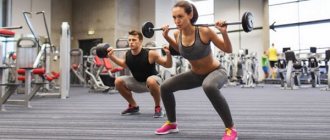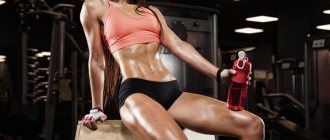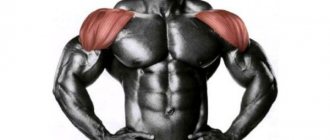Shoulder exercises help create a beautiful relief, neat contour and volume. But in this matter, the following are important: systematicity, a well-planned training program, and planned loads. You should choose the type of exercise that will allow you to work out the locally necessary muscle groups. But in order to know exactly what to focus on, you need to at least understand the anatomical structure of human shoulders.
What muscles are included in the anatomy of the shoulders?
The shoulder girdle connects the arms to the body. And the shoulder starts from the upper joint and ends in the elbow area. And these two concepts should be distinguished, because many are accustomed to perceive them as one whole.
Therefore, let's first look at which muscles are located where, so that later, when performing exercises, we can distribute the load to those muscle groups that especially need it.
Upper limb belt includes:
- deltoid muscle (forms a pronounced bulge, helps strengthen the shoulder joint);
- supraspinatus and infraspinatus muscles;
- teres minor and teres major muscles.
The shoulder consists of the following types of muscles:
- coracobrachial;
- brachial;
- two-headed;
- triceps;
- ulnar.
We won’t talk in detail about the anatomical features of all groups and types; let’s go straight to the main thing - we’ll figure out how to pump up the shoulders, taking into account the location of each type of muscle on the human body.
BUTTERFLY IN TILT
THE BASIS:
Bent-over arm raises
We recommend reading: Why muscles grow faster in men and women: growth factors
PURPOSE OF THE EXERCISE:
Posterior and anterior delta bundles
START:
Take a deep bend position, holding light dumbbells in straight arms. The grip is neutral. EXECUTION: With a powerful dynamic effort, spread your arms with dumbbells to the sides, and then bring your arms straight in front of you along arcing paths. At the end point of the movement, take a short static pause and return the dumbbells to their starting position on the floor. If there is no pause, then the weight of the dumbbells is too heavy.
Effective exercises for training
There are various training sets, including both basic and local (isolated) sets of exercises. But let's sort it out in order.
Lifting the weight up (base)
These classes are especially effective and efficient for those who want to increase delt mass. The main load is taken by the anterior and lateral zones of the deltoid muscles. The execution technique includes five main sequential actions:
- sit down on a bench and then put the apparatus on your shoulders (someone should help you with this);
- bring your shoulder blades together and push your chest forward;
- grab the bar wider than your shoulders;
- lift the barbell above your head until your arms are fully extended. Make sure your head is slightly tilted forward. Remember about breathing - you cannot hold it, exhale is always done while straightening your arms;
- the last stage is the slow return of the bar to its original position. Repeat the shoulder exercise for a few more sets.
To reduce pressure on the spine, you should choose a bench with a backrest.
Overhead chest press
It should be done by analogy with the previous option. Please note:
- the bar is placed not behind the head, but on the chest;
- when lowering the sports equipment, it is necessary to move your elbows slightly forward;
- When pressing the barbell up, do not change your body position (do not lean back or bulge forward). Try to keep your body as straight as possible and your arms in the same plane as your body. Remember to breathe correctly - straighten your arms, exhale, and then inhale smoothly. Don't hold your breath.
This type of training shifts the main load to the anterior deltoid muscles.
Chin pull
This basic shoulder exercise is recommended to be performed with dumbbells or a curved EZ bar. This will take the stress off your wrists. Thanks to this, they will take the most natural position.
Technique:
- take a barbell or dumbbells so that the girth is slightly narrower than shoulder width;
- your arms must be slightly bent at the elbows;
- using the shoulder muscles, pull the projectile up almost to the chin (but do not touch it), reducing the tension in the triceps and biceps as much as possible;
- try to ensure that your shoulders are always lower than your forearms. Lower the dumbbells. This must be done a little slower than when lifting. This way you can distribute the load evenly. You should also remember about breathing - at the highest point, exhale, when lowering the projectiles, inhale slowly.
Hands to the side
Above we looked at the base. These workouts should be done with special equipment in the gym. Let's move on to local exercises that can be performed without problems at home with minimal sports equipment.
The first option is to raise your arms to the sides. To perform this, you will need dumbbells of optimal weight.
In this case, we pump the shoulders in the area of the middle delta beams. The technique consists of five main actions:
- stand straight, bend your elbows slightly;
- begin to slowly lift the dumbbells to the sides. Do this until your arms are parallel to the floor;
- fix the position of your hands for a few seconds;
- begin to slowly return the dumbbells to their original position, lowering them.
Important! The arms should be slightly bent at the elbow. The main goal of this exercise is not to raise them as high as possible, but to ensure that the shoulders are perfectly parallel to the floor.
Watch your momentum, do not swing your body, lean back or lean forward.
"Arnold Press"
This is the best shoulder exercise that allows you to fully work out the front deltoids. To do this you will also need a pair of dumbbells of suitable weight. It consists of the following actions:
- take dumbbells, turn your palms towards you;
- now you need to bend your arms at the elbows and, without spreading your palms, press your shoulders to your body;
- after that, start pressing the dumbbells up. Moreover, it is important not to “throw” them out with jerks, but to smoothly lift them, rotating your wrists at a time when the elbow area rises to the level of the chin;
- When you return your hands to their original position, turn your wrists in the opposite direction.
To get started, just do as many repetitions as you have the strength to do. After some time, you can add 3-5 approaches.
Dumbbell Raise
This is an effective way to pump up the front deltoids. Sports equipment is raised in front of you. To do this you need:
- take the starting position standing. In this case, hands with dumbbells are located in front of the thighs;
- make a grip with your palms facing you;
- bend your elbows slightly;
- raise the dumbbells in front of you.
Important! The goal of this exercise is to ensure that the highest point of lifting the dumbbells is reached at the moment when the shoulders are parallel to the floor. You cannot raise your arms suddenly or jerkily. It is forbidden to help with the body - it must be “fixed”.
Seated press
If you do shoulder exercises at the gym, it's a good idea to try the following technique:
- sit on a bench;
- place your hands with dumbbells on your shoulders;
- push your chest forward slightly and bring your shoulder blades together;
- start squeezing the shells with slow movements, lifting them above your head and straightening your arms at the elbows;
- slowly return to the starting position.
How to build a workout
Regardless of the purpose of the training, the set of workouts is almost the same. Most methods are equal in terms of load intensity. They can be used at any stage of the workout, with the exception of deadlifts. Before pumping up the trapezoid at home, you need to select 2-3 exercises so that they work as hard as possible to pump it up. Beginning athletes can structure their training in this way:
- intense tension - the training is performed actively until complete fatigue, it is enough to select 2 names, doing it for as long as possible;
- intervals - do 4-5 tasks with large intervals between approaches, to ensure restoration of the muscles involved, 4-5 stages will be needed;
- increasing weight – the complex increases the athlete’s strength and endurance, the weight is increased after each approach, it is enough to perform 2-3 exercises, increasing the weight on the last one to the maximum permissible;
- pumping - choose the maximum weight with an increased number of repetitions, perform it for two exercises.
To improve the result, gradually increase the weight and combine several methods. All you need is a kettlebell, dumbbells and a barbell. Exercising on horizontal bars also pumps up muscles, but due to the static load, it is quite difficult to track their effect. Athletes are often interested in how to pump up the trapezius at home, so as not to overdo it. The technique is selected individually, taking into account physical capabilities. Training can be alternated by day. To increase strength indicators, it is recommended to choose the first and third varieties, and to form relief outlines, the second and fourth methods are appropriate.
Comment from the clinic's nutritionist:
In order for the training to bring maximum effect, you must follow a diet. There is no need to eat unhealthy foods; the diet is balanced. It is advisable to increase the volume of protein foods, but also include carbohydrates and fats. Portions should be small, but such that they replenish the pumped calories. When creating a menu, it is recommended to pay attention to the sports nutrition diet. The athlete must consume large amounts of water. Training is combined with sufficient rest so that the body has time to recover after intense exercise. One workout lasts about an hour, you need to set aside 7-8 hours for sleep.
When forming the volume of the trapezius, you should pay attention to exercises with your own weight. These include classic push-ups, planks, Cobra, and exercises on the horizontal bar. During the push-up process, the lowering is performed until the chest touches the hands. In this case, the elbows are pressed as close to the body as possible, and the back, arms and hips are placed in one line. The press is performed very slowly to thoroughly work each muscle. It is enough to do 3 sets of 30 times.
"Cobra" resembles a classic plank. The initial position is a plank. The athlete smoothly lowers himself onto his stomach as high as possible, raising his legs, arms and shoulders up. You need to hold this position for as long as possible, at least 1 minute. Many athletes use exercises once every two weeks to pump up their trapezius. Despite the fact that the muscles are adductors, at least one workout per month should be completely devoted to their full development. With the right approach, they quickly increase in volume.
Features of drawing up a training program
All the exercises mentioned above allow you not only to pump up your shoulders, but also to create an ideal V-shaped figure. For better results, you need to train not chaotically, but according to a specific program. But there are certain features in this matter that you should be aware of:
- any shoulder training program should include sets of exercises for various muscle groups in this area. It is important to work on each zone. This is the only way to achieve ideal relief and a beautiful contour. If there is a need to work on individual parts (upper, side, front), then you should simply increase the number of approaches;
- We must not forget about pre-warming the muscles and joints - this minimizes the risk of damage;
- Each next lesson should be based on varying certain exercises and carefully working out muscle mass from different angles. This contributes to the proper development and formation of the silhouette you need;
- Don’t forget about rest and train every other day.
Indicators of a Good Shoulder Training
Recreational levels of training, both shoulders and other body parts, should include the following important concepts:
- Reliance on multi-joint exercises in some weight range
- Variety of Workouts for Maximum Overall Growth Possible
- Working with free weights instead of exercise machines
- Sufficient weight and intensity for good hormonal response
At this point in your training, it's all about building a base by doing the best exercises (barbell presses and dumbbell swings) and some variations of the overhead press would be the best option for building your shoulders. Some variations, including the dumbbell press, are more difficult to perform if you haven't done them before. There are many questions regarding the correct barbell or dumbbell press technique to train your shoulders for mass without damaging them. Master this exercise because it will become the foundation of your overall shoulder training for your training career.
Seated dumbbell overhead press
You may not find a warm-up necessary as a beginner, but it will become more important as the weight increases and you work your shoulders to the max. Simply put, you can lift more weight if you do a few simple exercises beforehand. As you get closer to the working weight, rotate the workout towards a slightly heavier weight (failure around rep 6) rather than normal (failure around rep 8-12). The best time to bench press heavy weights is at the very beginning of your workout, when you are full of strength and muscle failure is still far away.
While many programs are based on a pyramid, in which you train with increasingly heavier weights on each subsequent set, the following examples are based on reverse pyramids, where you perform the exercise to failure while reducing the weight of the barbell or dumbbells on each subsequent exercise . After a good warm-up, immediately perform 1-2 approaches with heavier weights, reducing the weight in subsequent approaches, taking into account the accumulated fatigue. Reduce the weight by about 5 to 10 percent so that the shoulder exercises are performed at maximum intensity and in the indicated number of repetitions.
After the bench press, finish your workout with a single-joint exercise that will allow you to work each section of the deltoids: front, middle and rear.
For better performance, the workout should be completed using a muscle pump. The end of the workout, working out the lagging groups, is the only one that does not follow the standard protocol for performing multi-joint exercises.
We recommend reading: Back and biceps training
For each shoulder treatment option, follow the rules:
- Warm-up is not included in the training process. Do as much as necessary, but never warm up to the point of muscle fatigue.
- After warming up, choose a weight that will allow you to reach muscle failure for the specified number of repetitions. The number of reps should be varied in a reverse pyramid fashion, meaning that you lightly decrease the weight to increase the number of reps each after the first two sets. It is important that in each approach the muscles work to failure.
- You want to expand your range of exercises to target different muscle groups in different ways. Our job is to show you some new moves. Don't be afraid to try something new. When studying a new movement, read the literature. Improper execution can cause stress on a joint or other muscle group.
Example program
A lot here depends on what goals you are pursuing.
If you want big shoulders, then the following training plan is suitable: Exercise Number of repetitions Seated dumbbell press from the shoulders up from 5 to 10 Lifting equipment in front of you from 5 to 10 Lifting dumbbells to the chin from 7 to 15 Raising arms with weight to the sides from 7 to 15 “Arnold press” 7-8 times
You must understand that good results can be obtained by doing exercises regularly and every other day.
To create a beautiful relief of the body as a whole and an ideal contour with a clear “drawing” of the muscles, the following training plan is suitable:
Exercise Number of repetitions Pressing up from the chest (with dumbbells or a barbell) about 7-8 times Pressing to the chin from 5 times Raising the arms to the side 10 times Raising dumbbells forward from 10 times Pressing a barbell behind your head from 5 times
The number of repetitions is indicated for the entry level. You can gradually increase the load by adding 2-4 sets. In addition, you can include other types of exercises in your shoulder training program, depending on what results you want to achieve.
Men should stick to the given schedule, but girls can halve the load.
To fully understand and understand how to perform the exercises correctly, we suggest you study several videos.
Exercise videos
How to build big shoulders: mass training
Goal: building up all the deltoids
The most effective method for pumping up your shoulders in the gym is to work with heavy weights, but you need to approach the training correctly so as not to get injured. To do this, you need to warm up well and follow the exercise technique.
To build shoulder mass, always start your workout with the most difficult exercises (in this case, overhead presses) that allow you to lift more weight. Then perform single-joint exercises on each of the three deltoids: anterior, middle, and posterior. This will set the stage for muscle building work as long as you maintain your overall training volume.
When we pump our shoulders, we can complicate the training in several ways. For the overhead press, start by using dumbbells, which are notoriously more difficult to balance and allow for a greater range of motion than a barbell. You'll also do the reverse pyramid because it gives you the opportunity to do more sets with muscle failure. For the first 2 sets, you'll use fairly heavy weights in a low rep range (6) to build strength. As fatigue accumulates in subsequent approaches, reduce the weight by about 5 kg. Perform the last 2 heaviest approaches with a belay partner so that you can maintain technique.
Because the front delts do a lot of the work in chest training, and the middle delts bear the brunt of the weight during the overhead press, the rear delts often remain small and weak. In this workout, shoulder pumping takes place when you have a lot of strength in reserve. At the same time, don't be afraid to change the order of single-joint exercises based on your weaknesses. If you think that all of your deltoids are proportionally developed, simply perform these exercises in a different order at each workout.
Massive shoulder training program
- Dumbbell overhead press - 4 sets of 6,6,8,10 reps (2 minutes rest)
- Barbell rows to the chin - 3 sets of 8,8,10 reps (2 minutes rest)
- Bent-over dumbbell raises - 3 sets of 8, 10, 12 reps (1 minute rest)
- Standing dumbbell lateral raises - 3 sets of 8,10,12 reps (1 minute rest)
- Lifting the barbell overhead with straight arms - 3 sets of 8,10,12 reps (1 minute rest)











